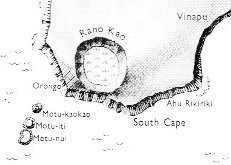|
TRANSLATIONS
With He Maro (June) the cycle of the yearly path of the sun is completed. Poetic logic would try to fuse this fact with the appearance of Ana-muri (Aldebaran) in the sky as a signal for darkness ('tattoing'), or with the appearance of Ana-iva (Phaed) as a signal for the 'exit' of the old sun. I have (loosely) coordinated Ana-muri with Vaitu poru from the fact that Aldebaran is halfway around the circle from Antares (Ana-mua) in Ko Ruti. Antares should be located in Ko Ruti because the rectascension number is 16h 26, or ca ⅔ of 24, counted from spring equinox north of the equator. South of the equator we count from autumn equinox. Ca 16½ half-months from 21 March will though lead us to the 1st half of December (Ko Koró), rather than to Ko Ruti. 16 half-months is 8 months and 8 months beyond 21 March is 21 November. 15 days more leads us to ca 6 December. Ana-nia (Polaris), the symbol for winter solstice, could not have been sighted. Easter Island is located ca 27º S and that is more than the tilt of the Earth (ca 23½º). 24 stations of the kuhane can be aligned with the 24 half-months of the year. Barthel has coordinated Te Kioe Uri and Te Piringa Aniva with He Maro:
Te Kioe Uri would then correspond to the appearance of Ana-muri (Aldebaran) and Pua Katiki to the appearance of Ana-mua (Antares). Both stars would function as signals for the coming solstice event, in Te Piringa Aniva respectively in Maunga Teatea. The names agree: Muri sounds like uri and the opposite colour, tea, is doubled at summer solstice (teatea). At summer solstice sun is very high, as if at the top of a mountain (mauga). The opposite pole, winter solstice, should be as if deep in murky water. Vaitu, the beginning of the 4th quarter points to water (vai). Mua sounds like pua (in Pua Katiki). A flower (pua) is like the sun, attracting butterflies. The 1st kuhane station is Nga Kope Ririva, and this suggests a year beginning beyond autumn equinox, not a year beginning beyond winter solstice. Turning the dial a quarter from the solstices, we will have autumn equinox at 0h (because autumn equinox south of the equator corresponds to spring equinox north of the equator), and the first pillar to arrive will then be Ana-nia:
The pillar to fish by evidently stands in the water and so do the three kope ririva: ... The dream soul of Hau Maka countinued her journey and, thanks to her mana, reached another land. She descended on one of the small islets (off) the coast). The dream soul of Hau Maka looked around and said: 'These are his three young men.' She named the three islets 'the handsome youths of Te Taanga, who are standing in the water' [1 Nga Kope Ririva Tutuu Vai A Te Taanga].
Polaris is invisible from Tahiti and Easter Island, therefore a good symbol for the murky water at the beginning of the year. The rectascension number (01h 49) tells us, though, to move forward from 21 March (in Maunga Hau Epa), and to put the pillar at a location ca (1 + 49/60) / 24 times 365.25 = ca 28 days ahead, in Te Pu Mahore. ... The dream soul of Hau Maka continued her journey and went ashore on the (actual Easter) Island. The dream soul saw the fish Mahore, who was in a (water) hole to spawn (?), and she named the place 'Pu Mahore A Hau Maka O Hiva' [2 Te Pu Mahore]. I have earlier arrived at the conclusion that Te Pu Mahore should have number 1: ... Te Pou should have an odd number and to reach that I propose that number 1 be given to Te Pu Mahore. Remember that pú means to walk in front. Standing on the three islets we reach Te Pu Mahore with the fist stride. The three islets correspond to 'zero', the starting point. Makoi does not return all the way to the three islets, he reaches Te Pu Mahore and then returns ... The ana list from Tahiti has 10 stars, the last of which is Ana-nia (Polaris). The order is by rectascension numbers, i.e. the order in which they appear in the sky during the year, yet only during the dark winter season. The beginning (Te Pu Mahore) is the end (Ana-nia). Only by offering will there be a return:
Mahore (ma-hore) seems to allude to Maharu (ma-haru), the night immediately before Ohua. If the the recently dead people (aniva) should follower their leader once in a year up into the sky along the Milky Way (aniva), then Te Pu Mahore ought to catch our attention. That is the station when the leader offers himself to the gods in order to secure a good crop the coming new year:
But there may be an interval beyond his death and his leaving, a long travel needs a time for preparation: ... The cult place of Vinapu is located between the fifth and sixth segment of the dream voyage of Hau Maka. These segments, named 'Te Kioe Uri' (inland from Vinapu) and 'Te Piringa Aniva' (near Hanga Pau Kura) flank Vinapu from both the west and the east. The decoded meaning of the names 'the dark rat' (i.e., the island king as the recipient of gifts) and 'the gathering place of the island population' (for the purpose of presenting the island king with gifts) links them with the month 'Maro', which is June. Thus the last month of the Easter Island year is twice connected with Vinapu. Also, June is the month of summer solstice [a mistake: winter solstice], which again points to the possibility that the Vinapu complex was used for astronomical purposes ... Could the Milky Way connect with the earth (at the western horizon) in the season of Vinapu? |
|||||||||||||||||||||||||||||||||||||||||||||||||||||||||||||||||||||||||||||||||||||||||||||||||||||||||||||||||
